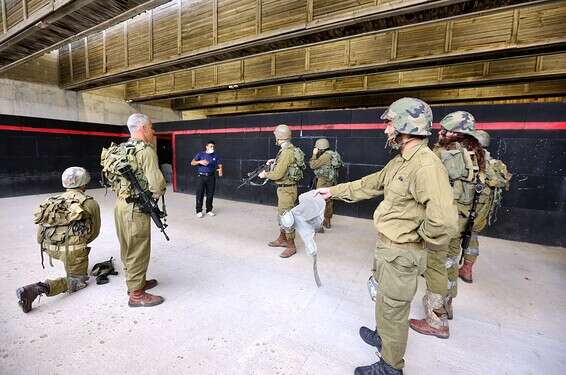The IDF has begun to train reservists to operate in outposts that were previously the property of the special units.
"The nature of the fighting of recent times requires of us other methods also among infantry soldiers in reserve.
It is no longer enough to conquer the hill, but very small contacts must be reached with a minimum of weak points.
This is a fighting that was previously reserved for special units. "
Chief of Staff Kochavi, last week: I instructed the IDF to prepare new operational plans for the treatment of Iran // Photo: Institute for National Security Studies
This is how Brigadier General Dan Goldfuss, a senior infantry and paratrooper officer, analyzes, in his first interview since taking office, the new combat pattern of combat reservists, which is being implemented in an advanced training complex that has recently opened.
A senior IDF officer claims that in doing so they are correcting some of the deficiencies pointed out by Maj. Gen. (Res.) Yitzhak Brick, and admits: "There is truth in the criticism, we are correcting the deficiencies but it takes time to move the ship." , And indicate much more severe untreated defects.
The basic premise of the new method of work is based on the understanding that in the next war the fighters will have to operate in a built-up area, door to door, on a much larger scale than what an infantry fighter required in the past. Therefore, the IDF now emphasizes each soldier , At a particularly high bar, and lasts until the end of the combatant's service in the reserve.
As part of the changes, every infantry fighter in the reserve is expected to train four times a year, in a new compound called the "Training Arena" in the Sorek area in the South.
In contrast to the familiar training, in which the fighters are led by their commanders, themselves reservists, this compound is operated by Elbit instructors, which allows for an examination of the fighters' activities in a cleaner and more professional manner.
In addition, in this method the fighters are not required to spend unnecessary time getting organized, as is well known to reservists.
"We want to see the fighter all the time and what needs to be improved to prepare him for battle. In the new method, the reservists do not have a wasted minute. When I was a reserve brigadier, they always told me that the fighters were sitting and doing nothing.
Today there is no such thing.
"Those who are late will go home," says Goldfuss. "The training in the new method is praised from wall to wall by the fighters who trained there." It is the best training I have done in my 11 years in the reserve, "said one of the company commanders.
Logistical problems
But there is also a second and more murky side to the coin.
A few years ago, it was decided that the reserve units in the reserve, which would enter the depths of enemy territory at the beginning of the war, would have more training days, while the training of the other combat units would be cut.
Thus, paratrooper units in reserve receive long training weeks a year, while other units receive less time spread over a long period of time.
This arouses resentment among commanders, who feel that their unit is considered type B and is not ready for war.
"We are building on the units training during the war, but what if there is no time?"
Wonders a senior officer in the reserve.
Moreover, while it is apparent that the method strengthens the ability of the lone fighter, senior reserve officers believe that it is merely branding, and that the battalions and brigades are unprepared for serious logistical problems.
"There are armored brigades that do not have even one proper refueling truck, and in the moment of truth they will have to find urgent solutions in the field. The fact that you are training an infantry battalion in a training facility is terribly shiny and beautiful, but it is time for the military to stop branding.
With all due respect, a military force at the brigade level and above is not just a 'Pio Pio' at 16-M, but it needs a strong logistical tier.
We cannot afford scenarios of three weeks of fighting without proper logistical capability - water, fuel, ammunition.
It all comes in trucks. "
"Are we ready to fight and win it? Yes. Is it possible to do better? Yes," Goldfuss nods in response to these complaints, "for years we have told ourselves that the battlefield is changing, but we have not trained the qualifications of reservists. Now we are taking steps in that direction. "A war that we want to defeat the dug-out enemy will have to use a ground force that works in a combined way. Are we the best there is? In my opinion not, so we are strengthening the fighters, who will know how to bring the X Factor."
Goldfuss warns that if the regular service of the fighters is shortened, it will harm the readiness of the IDF. "This will mean harming the fighters on the battlefield.
We are in minimum training, taking a lemon and squeezing it to the limit. "

